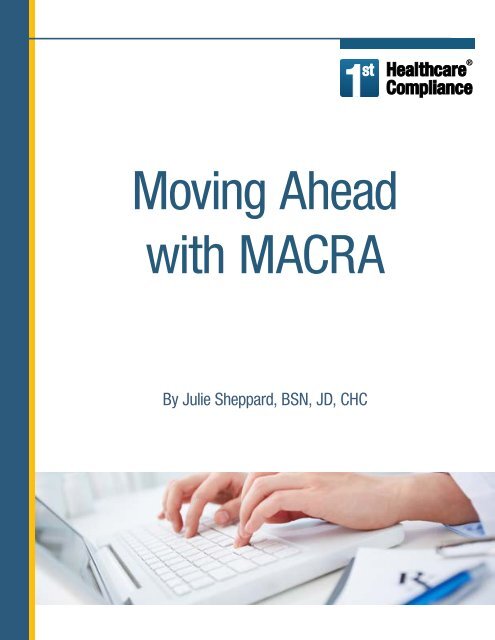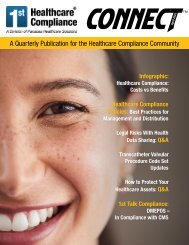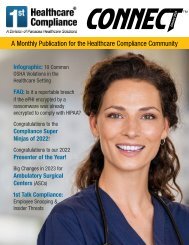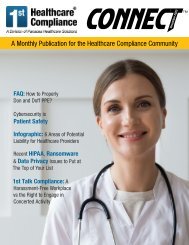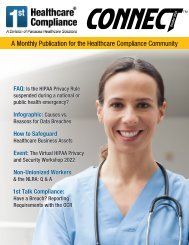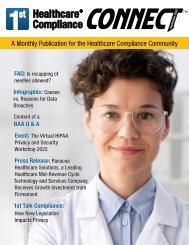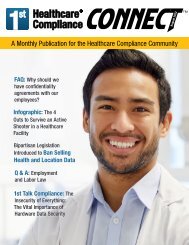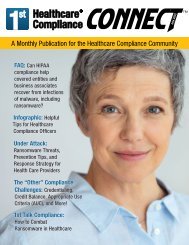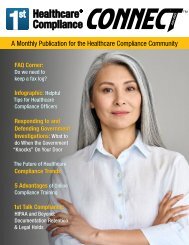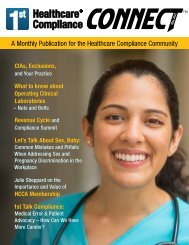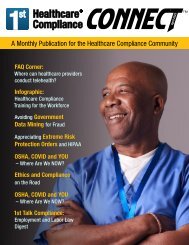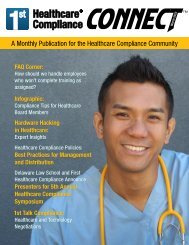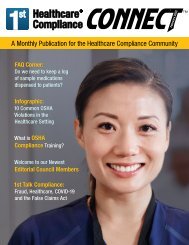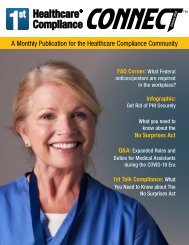1stHCC eBook- MACRA
You also want an ePaper? Increase the reach of your titles
YUMPU automatically turns print PDFs into web optimized ePapers that Google loves.
®<br />
Moving Ahead<br />
with <strong>MACRA</strong><br />
By Julie Sheppard, BSN, JD, CHC
Table of Contents<br />
1 Introduction<br />
2<br />
3<br />
4<br />
7<br />
Getting on Track with <strong>MACRA</strong><br />
Who is Eligible to Participate in MIPS?<br />
Common Misconceptions<br />
MIPS Hurdles<br />
®<br />
8<br />
Creating a MIPS Action Plan<br />
9<br />
Your Impact
Introduction<br />
®<br />
The Medicare Access and CHIP Reauthorization Act of 2015 (<strong>MACRA</strong>)<br />
presents a shift toward value-based care. <strong>MACRA</strong> permanently repeals<br />
the Sustainable Growth Rate (SGR) formula, changing to value over<br />
volume for reimbursement. The Quality Payment Program (QPP)<br />
eliminates and replaces previous programs with the Merit-based<br />
Incentive Payment System (MIPS) and provides bonus payments<br />
for participation in eligible Alternative Payment Models (APMs). It’s<br />
important to understand how <strong>MACRA</strong> and the final rule published on<br />
November 2, 2017, will impact your bottom line when it goes into effect<br />
on January 1, 2018. There are many options to consider in determining<br />
the best course of action.<br />
© 2017 First Healthcare Compliance 1
Getting on Track with <strong>MACRA</strong><br />
®<br />
<strong>MACRA</strong>, MIPS and APMs continue to dominate the compliance conversation.<br />
The Quality Payment Program has two tracks: MIPS and APMs.<br />
Although the number of clinicians participating in an APM is expected to<br />
increase under the final rule, MIPS is accessible to a larger number of<br />
providers. APM is an alternative based model with incentive payments,<br />
but only a small percentage of alternative payment models qualify as Advanced<br />
APMs for 2017, meaning that most providers who receive Part B<br />
payments will need to participate in the MIPS program or face a penalty.<br />
Executives and providers lack familiarity and confidence as the new value<br />
based system will impact their financial reimbursement over a period<br />
of years. Confusion and discontent are present as providers and managers<br />
struggle to make decisions regarding their approach to regulations<br />
that will determine the amount of their future Medicare reimbursements.<br />
MIPS is going to have a growing impact on reimbursement with penalties<br />
and bonuses. It’s important to weigh the costs and benefits of participation<br />
in MIPS. Managers may consider multiple components when determining<br />
which route to pursue.<br />
Results of a recent MGMA survey indicate that MIPS tops the list of regulatory<br />
burdens as most of the medical practices surveyed identify the<br />
Medicare Merit Based Incentive Payment System as either “very” or “extremely”<br />
burdensome. While getting on track with MIPS is a challenge,<br />
it’s worth addressing a few common misconceptions and creating an<br />
action plan.<br />
© 2017 First Healthcare Compliance 2
Who is Eligible to Participate in<br />
MIPS?<br />
®<br />
The list of MIPS eligible clinicians in years one and two includes: Physicians<br />
(MD/DO and DMD/DDS), PAs, NPs, Clinical nurse specialists, and Certified<br />
registered nurse anesthetists.<br />
The list of MIPS eligible clinicians may include a broader list in year<br />
three including: Physical or occupational therapists, Speech-language<br />
pathologists, Audiologists, Nurse midwives, Clinical social workers, Clinical<br />
psychologists, and Dietitians/Nutritional professionals.<br />
MIPS consolidates previous programs into four performance categories.<br />
Providers choose the activities and measures with:<br />
• Quality- Replaces PQRS<br />
• Improvement Activities- New category<br />
• Advancing Care Information- Replaces Meaningful Use<br />
• Cost- Replaces Value Based Modifier<br />
© 2017 First Healthcare Compliance 3
Common Misconceptions<br />
®<br />
“Complying with MIPS is going to be time consuming and costly, so<br />
we should just skip it this year.”<br />
It’s not that difficult to avoid the penalty. With minimal effort during 2017<br />
you will retain 4% more of your Medicare earnings in 2019. Completing<br />
any of the following would earn at least 3 overall MIPS points and avoid a<br />
penalty:<br />
• Report one quality measure (on at least one patient)<br />
• Attest “yes” to completing one improvement activity<br />
• Report or attest to the four Advancing Care Info (ACI) base measures<br />
It’s a good idea to submit more than one measure if possible. Consider it<br />
insurance to provide a margin of error. Reporting one quality measure on<br />
one patient isn’t very burdensome. However, if performing an improvement<br />
activity or the ACI base measures, you’ll need a consecutive 90 -day period<br />
to submit so the opportunity for 2017 isn’t available.<br />
The 90 days of consecutive data must be submitted in three categories:<br />
• Improvement activities<br />
• Advancing care info<br />
• Quality<br />
© 2017 First Healthcare Compliance 4
Common Misconceptions<br />
®<br />
“I don’t want to invest time and resources into something that might<br />
go away during the next couple of years.”<br />
While no one has a crystal ball to predict the outcome of government<br />
volatility, we have no reason to expect <strong>MACRA</strong> to go away. <strong>MACRA</strong>, the<br />
second-most significant health law signed into law by President Obama,<br />
is almost certain to survive in some form. The Affordable Care Act (ACA)<br />
and <strong>MACRA</strong> are different. The focus of the ACA is on providing more<br />
access and reducing spending. <strong>MACRA</strong> is the result of a bipartisan effort<br />
and establishes a new way to reimburse physicians caring for Medicare<br />
beneficiaries. Under <strong>MACRA</strong> we will transition from a fee for service<br />
world to a value based payment system with the intent of saving money<br />
and improving quality. Even elimination of the ACA would not, therefore,<br />
eliminate <strong>MACRA</strong>.<br />
© 2017 First Healthcare Compliance 5
Common Misconceptions<br />
®<br />
“I’m still not sure that MIPS applies to me.”<br />
If you think MIPS doesn’t apply to you, you probably need to think again.<br />
There is a possibility that you are exempt, but it is not likely. In 2017, there<br />
are three exemptions from MIPS for clinicians who otherwise meet the<br />
eligibility requirements:<br />
• First year Medicare Part B participants<br />
• Clinicians billing Medicare Part B less than $30,000 in allowed<br />
charges or providing care for fewer than 100 Part B patients in one<br />
year<br />
• Providers sufficiently participating in an APM<br />
© 2017 First Healthcare Compliance 6
MIPS Hurdles<br />
®<br />
Some hurdles to MIPS relate to more practical questions.<br />
Can we submit the data through our EHR? Some EHRs submit data<br />
directly to CMS. However, there are other data submission methods such<br />
as a qualified registry.<br />
Is there anything else we should know about attestation? If you don’t<br />
use an EHR you’ll be able submit via the CMS Quality Payment Program<br />
website, a qualified clinical data registry, or a qualified registry. Groups of<br />
25 or more may choose to use the CMS Web Interface. Remember, it’s<br />
best to retain documentation according to the CMS document retention<br />
policy.<br />
Is there an easy way to find the MIPS measures for my specialty?<br />
The QPP offers help with an interactive web site.<br />
How are Improvement Activities scored? The weighting and scoring<br />
varies based on factors such as whether your group has 15 or fewer<br />
clinicians. CMS provides a fact sheet with more information about scoring.<br />
If we chose to submit something to avoid a penalty, exactly what<br />
should we submit? If you are working to avoid a penalty this year, the<br />
AMA provides a helpful video.<br />
How do we know if our EHR is certified as a Data Submission Vendor?<br />
Check in with your appropriate REC for assistance.<br />
Should we report individually or as a group? QPP provides a resource<br />
for learning more about the differences in reporting as an individual or as<br />
part of a group.<br />
© 2017 First Healthcare Compliance 7
Creating a MIPS Action Plan<br />
®<br />
It’s critical to have an action plan for successful participation in MIPS. The<br />
AMA provides a ten-step action plan especially for physicians who plan<br />
to participate in MIPS and not as part of an advanced APM. The AMA<br />
also provides tools for determining MIPS eligibility and evaluating financial<br />
impact on a practice.<br />
Among the AMA recommended steps is performing a security risk analysis<br />
if reporting ACI measures. Because patients’ protected health information<br />
is stored electronically the risk of a breach of their electronic protected<br />
health information (ePHI) is increased. CMS emphasizes that there is no<br />
single method or “best practice” that guarantees compliance, but most<br />
risk analysis and risk management processes have steps in common.<br />
MEDICARE QUALITY PAYMENT PROGRAM<br />
THE BASICS<br />
MIPS ACTION PLAN<br />
10 Key Steps for 2017<br />
The Medicare Quality Payment Program (QPP) began on January 1, 2017 and requires that eligible physicians and certain<br />
non-physician practitioners participate in either the Merit-Based Incentive Payment System (MIPS) or in an advanced<br />
Alternative Payment Model (APM). MIPS-eligible clinicians that do not participate in either track in 2017 will receive a<br />
4% penalty in their 2019 Medicare reimbursement. More information is available at the AMA’s Understanding Medicare<br />
Payment Reform site.<br />
HOW TO USE<br />
This Action Plan is intended for physicians who plan to participate in MIPS and not as part of an advanced APM. (If you<br />
are unsure whether you are MIPS eligible or exempt, you can check your status through CMS’ MIPS-eligibility look up<br />
tool. You can also use the AMA Payment Model Evaluator tool for a personalized assessment of the financial impact on<br />
your practice.)<br />
The steps below are to assist you with successful MIPS implementation. For more detailed information, refer to the<br />
MIPS Action Plan Supplementary FAQs. Keep in mind that completion of certain steps (for example, Step 7, “Perform a<br />
Security Risk Assessment,” and Step 8, “Report for at Least 90 Days,”) may or may not be applicable, depending on your<br />
level of MIPS participation.<br />
STEP 1<br />
STEP 2<br />
STEP 3<br />
STEP 4<br />
STEP 5<br />
STEP 6<br />
STEP 7<br />
□ Determine whether MIPS Applies to You<br />
□ Review Available Performance Categories<br />
□ ‘Pick Your Pace’ for MIPS Participation<br />
□ Review your Data<br />
□ Decide whether to Report as an Individual or a Group<br />
□ Identify your Reporting Mechanism<br />
□ Perform a Security Risk Analysis*<br />
STEP 8 □ Report for at Least 90 Days* [CMS DEADLINE: OCT. 2, 2017]<br />
STEP 9 □ Complete MIPS performance [CMS DEADLINE: DEC. 31, 2017]<br />
© 2017 American Medical Association. All rights reserved. Page 1 of 5<br />
© 2017 First Healthcare Compliance 8
Your Impact<br />
®<br />
If you accept Medicare and/or Medicaid the final rule will impact you and<br />
your reimbursement for 2018. Under the Trump administration changes<br />
in the healthcare sector occur often yet CMS appears to continue the<br />
path toward value based care. CMS proposes updates for the second year<br />
of QPP to provide more flexibility. Here are some of the most significant<br />
changes for small providers participating in MIPS:<br />
• More flexibility for small providers<br />
• More small providers will fall under the exemption category with an<br />
increased threshold. The low volume threshold of $30,000 In Medicare<br />
Part B charges or 100 Medicare Part B patients will increase to a<br />
threshold of $90,000 or less in Medicare Part B charges or 200 patients<br />
annually.<br />
• New reporting options for hospital based physicians and solos and<br />
small groups. Hospital based doctors will be able to report on quality<br />
and cost in the facilities where they work. Their individual score will be<br />
calculated with the submission of the facility’s inpatient value-based<br />
score.<br />
• New virtual groups allow solo practitioners and groups with fewer than<br />
10 eligible providers to combine for a performance period of a year.<br />
Virtual Groups would be composed of solo practitioners and groups<br />
of 10 or fewer eligible clinicians who come together “virtually” with at<br />
least 1 other such solo practitioner or group to participate in MIPS for a<br />
performance period. Please note: the group would have to be assessed<br />
as a group on all MIPS categories.<br />
© 2017 First Healthcare Compliance 9
Your Impact<br />
®<br />
• Meaningful Use is replaced by Advancing Care Information (ACI) and<br />
allowing the 2014 edition of CEHRT for the 2018 calculations. However,<br />
a bonus will be issued in the category of ACI for use of certified 2015<br />
edition EHR.<br />
• Cost will not be a weighted category for 2018, but it is recommended<br />
to increase efforts in this area as cost scoring is still a category to<br />
be added in the future. For now, quality will remain the most heavily<br />
weighted category at 60% with more quality measures added.<br />
• Bonus points will be awarded by CMS for the following factors: caring<br />
for complex patients and being part of a practice with fewer than 15<br />
providers.<br />
If you’d like to learn more about MIPS and what it means for you, check<br />
out First Healthcare Compliance’s online training module and visit our blog<br />
for informative articles and infographics.<br />
© 2017 First Healthcare Compliance 10
Our Solution:<br />
Confidently manage compliance with the First Healthcare Compliance comprehensive compliance<br />
management solution which provides you the visibility, oversight, controls and tools to manage<br />
your organization’s compliance program from the topdown and from the bottom-up. Mitigate your<br />
risk and drive compliance with our customized, scalable cloud-based solution coupled with live<br />
support from our team of experts in healthcare compliance.<br />
First Healthcare Compliance<br />
www.1sthcc.com<br />
888.54.FIRST<br />
3903 Centerville Road<br />
Wilmington, DE 19807<br />
© 2017 First Healthcare Compliance LLC. All rights reserved.


